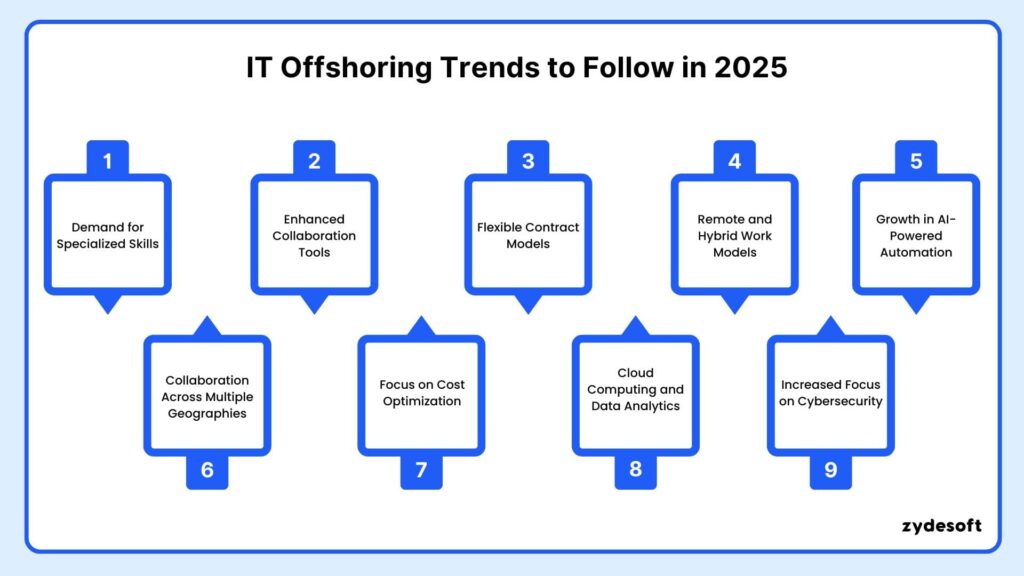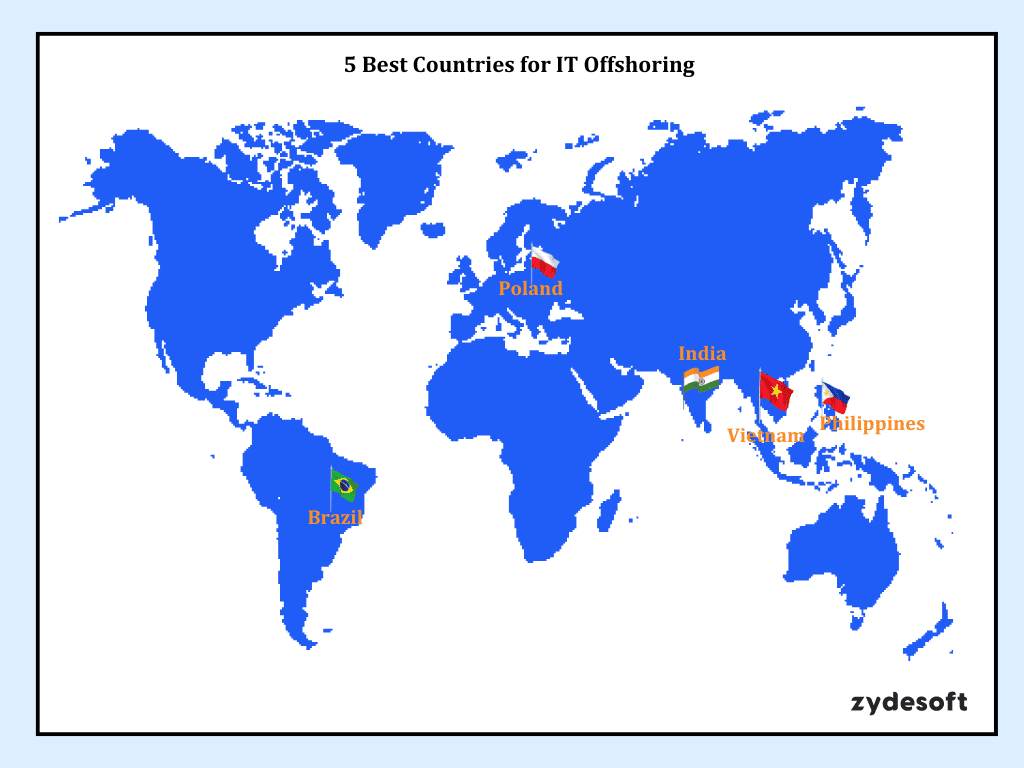
IT offshoring trends are continuously evolving as businesses looking cost-effective solutions and specialized tech talent. With the rise of hybrid work and digital transformation, companies are rethinking global hiring strategies to stay competitive.
According to Statista, the IT outsourcing industry is expected to generate $213.60 billion in revenue in the U.S. by 2025, highlighting the growing reliance on outsourced tech talent. However, evolving regulations, cybersecurity risks, and the rise of AI are reshaping offshoring decisions.
This article explores key IT offshoring trends, including the impact of remote work, emerging technologies, and innovative recruitment strategies. Whether you’re an HR professional or a business leader, staying ahead of these trends is essential for building a future-ready workforce.
Imagine running a marathon in a relay team—you hand over the baton to teammates who might be on the other side of the globe, ensuring your progress never halts. That’s IT offshoring—delegating your IT tasks, such as software development, tech support, or infrastructure management, to teams in other countries.
It’s a strategy businesses use to harness global talent, save costs, and maintain a competitive edge. In fact:
Offshore hiring is the process of recruiting talent from other countries, typically from regions where labor costs are lower than in the hiring company’s country. Companies often engage in offshore hiring to access a larger talent pool, reduce costs, or take advantage of specialized skills that may not be readily available locally.

The IT offshoring landscape is constantly evolving, shaped by technological advancements and changing business needs. As we step into 2025, several key trends are emerging that will influence how companies approach offshoring. In this section, we’ll explore the top IT offshoring trends to watch, giving you a clear picture of what’s ahead and how these trends in offshoring could impact the industry.
The fast growth of technology has created a higher demand for specialized skills. Companies are looking for experts in areas like artificial intelligence, machine learning, and data analytics. According to Forbes’s recent report, the global talent shortage is projected to reach 85.2 million by 2030, which could result in a loss of $8.5 trillion in potential economic growth.
To tackle this challenge, businesses are turning to offshore. Countries like India are stepping up as major hubs, with an expected surplus of over 1 million skilled tech workers by 2030. IT offshoring trends help businesses find the talent they need and offer significant cost savings, making it an attractive option for companies aiming to stay competitive.
Effective communication and collaboration are at the heart of successful offshoring. 86% of employees and executives believe that poor collaboration is a leading cause of workplace failures. To overcome these challenges, businesses are embracing advanced tools that help teams work seamlessly across time zones and locations, supporting trends in offshoring that prioritize efficiency and connectivity.
Here are some of the key tools shaping IT offshoring in 2025:
By adopting these tools, offshoring teams can enhance communication, improve transparency, and drive better project outcomes. Companies that integrate these solutions have reported increased productivity, better employee satisfaction, and faster delivery of high-quality work.
Flexibility in contractual agreements is becoming a cornerstone of successful offshoring strategies. Companies are shifting from rigid, long-term contracts to more adaptable models, such as time-and-materials, dedicated teams, or hybrid contracts. These models offer scalability, allowing businesses to adjust resources as project needs evolve or market conditions change a key factor in IT offshoring trends.
For example, a time-and-materials contract enables companies to pay only for the hours worked, making it ideal for projects with uncertain scopes. Dedicated team models, on the other hand, provide businesses with a full-time offshore team, ensuring consistent support for long-term goals.
This flexibility fosters innovation by allowing companies to experiment with new ideas without being locked into strict commitments. It also boosts efficiency by aligning resources with real-time project requirements. However, successful implementation requires clear communication and accountability to manage expectations and avoid misunderstandings.
By adopting flexible contract models, organizations can stay competitive, reduce risks, and respond quickly to changing business needs.
The global shift to remote and hybrid work is reshaping industries and influencing IT offshoring. Advances in technology and changing workforce expectations have made these models central to modern work strategies.
Key factors driving this shift include:
Hybrid models combine the flexibility of remote work with periodic in-office collaboration, offering businesses a balance between productivity and teamwork. For offshoring, these models enable companies to set up virtual teams, reduce operational costs, and access talent across time zones.
Artificial intelligence (AI) and automation are revolutionizing business processes. The integration of AI in offshoring allows for the automation of routine tasks, enhancing efficiency and accuracy. According to NAPA Global, the global AI market is expected to grow at an annual rate of 36.6% between 2024 and 2030, indicating the dominant position of AI in the IT outsourcing trend.
Offshore teams proficient in AI technologies are becoming invaluable assets, enabling companies to stay ahead in a competitive market.
India remains the top destination for IT offshoring, with 90% of the world’s top 500 companies setting up dedicated tech teams in the country. However, as the demand for skilled professionals rises, businesses are exploring other regions like Eastern Europe, the Americas, and parts of Asia due to the rise of trends in the offshoring landscape.
Countries such as Ukraine, Poland, and Romania are becoming popular nearshoring choices for Western European companies. Their smaller time zone differences, cultural similarities, and skilled talent pools make collaboration smoother. These regions offer a blend of affordability and expertise, helping businesses reduce costs while maintaining quality.
Effective collaboration across geographies requires robust strategies. Companies increasingly rely on tools like Slack, Zoom, and Trello to bridge communication gaps, ensure productivity, and manage diverse teams. By leveraging talent from multiple locations, businesses can scale their operations while fostering innovation through diverse perspectives.
Cost optimization remains a driving factor for offshoring decisions. However, the focus is shifting from merely reducing expenses to maximizing value. Companies are seeking offshore partners that offer not only cost advantages but also high-quality services and innovation. This holistic approach ensures sustainable growth and a competitive edge in the market.
Recent statistics highlight the financial benefits of offshoring:
By focusing on cost optimization through strategic offshoring, companies can achieve substantial financial benefits while maintaining high standards of quality and innovation.
The growth of cloud computing and data analytics is reshaping offshoring strategies. Companies are outsourcing cloud services to ensure scalability and efficiency, with the global cloud computing market projected to grow from $545.8 billion in 2022 to $1,240.9 billion by 2027. Offshore providers offer cloud migration, maintenance, and optimization, addressing the needs of enterprises managing vast data.
Additionally, the big data analytics market, valued at $271 billion in 2022, is expected to reach $655 billion by 2029, driving organizations to offshore analytics tasks to access specialized skills and infrastructure. By leveraging offshoring, businesses can harness insights for better decision-making, with 83% of companies recognizing data analytics as crucial for strategy.
This offshoring trend allows organizations to reduce costs while innovating, ensuring a competitive edge in an increasingly data-driven landscape.
As digital transformation accelerates, cybersecurity has become a top priority for businesses. Offshoring presents unique challenges in protecting sensitive data and meeting compliance requirements, prompting companies to demand stronger security measures from their offshore partners.
Key statistics underscore the urgency:
To address these risks, companies are partnering with providers that follow strict security protocols and international standards like ISO 27001 and GDPR compliance. Advanced measures such as data encryption, zero-trust security frameworks, and multi-factor authentication are being widely adopted to safeguard sensitive information.
Investing in robust cybersecurity measures not only mitigates potential threats but also strengthens trust with clients and stakeholders, ensuring long-term success in offshoring.
Companies engage in offshoring to reduce costs, access specialized skills, and improve efficiency. By outsourcing to countries with lower labor costs, businesses can save on wages and overhead. Offshoring also allows companies to tap into global expertise and operate around the clock due to time zone differences, enhancing productivity. Here are some common reasons why most of the companies looking offshoring:
The IT specialists market is growing rapidly, fueled by digital transformation, cybersecurity needs, advancements in cloud computing and AI, and the increasing reliance on data analytics to drive business decisions. Key insights include:
Despite these challenges, the IT specialists market offers substantial growth opportunities, driven by technological advancements and increasing digital dependence.
| Form of Outsourcing | Description | Example | Benefits |
| Offshore Outsourcing | Outsourcing to companies in distant countries, often with lower labor costs. | A U.S. company outsourcing customer service to India. | – Cost savings- Access to specialized skills- 24/7 operations |
| Nearshore Outsourcing | Outsourcing to neighboring or nearby countries. | A U.S. company outsourcing to Mexico or Canada. | – Lower costs than domestic outsourcing- Similar time zones and cultures. |
| Onshore Outsourcing | Outsourcing within the same country. | A U.S. company outsourcing to another U.S. company. | – Easy communication- No language barriers, – Similar culture. |
| Business Process Outsourcing (BPO) | Outsourcing entire business functions like customer service or payroll. | Outsourcing a call center to a BPO provider. | – Cost reduction- Operational efficiency- Focus on core functions. |
| Knowledge Process Outsourcing (KPO) | Outsourcing high-level tasks requiring specialized knowledge. | Outsourcing legal research to a legal firm abroad. | – Access to specialized expertise and knowledge. |
| IT Outsourcing | Outsourcing IT-related services like software development or IT infrastructure. | A company outsourcing its software development. | – Access to cutting-edge technology- Scalability- Expertise. |
| Staff Augmentation | Hiring external staff for specific projects or tasks. | A tech firm hiring skilled developers for a project. | – Flexibility- Fast scalability – Access to specific skills. |

Offshoring software development is a growing strategy for businesses, offering cost savings, increased productivity, and access to global talent. With IT outsourcing expected to reach $397.6 billion by 2025 and a significant rise in global IT spending, companies must choose the right countries to ensure successful partnerships in this expanding market. This offshoring trend is transforming the way businesses develop software, enabling them to leverage global talent to enhance innovation and efficiency.
| Country | Strengths | Key Stats | Challenges |
| India | Vast IT professional pool, cost-effective labor, mature outsourcing industry. | $8.81 billion projected revenue in 2023, 12.25M GitHub accounts. | Quality inconsistency, varying skill levels. |
| Vietnam | Fast-growing ICT sector, skilled tech talent, cost-effective, strong tech infrastructure. | Projected $881.90M IT outsourcing sector by 2027, 480,000 IT engineers. | Limited time zones overlap with the West. |
| Philippines | High English proficiency, strong BPO industry, and government support for IT outsourcing. | 13% share of the global IT-BPM market, #1 in voice-related services. | Limited tech infrastructure compared to others. |
| Poland | Strong developer pool, EU data security standards, time zone alignment with Western Europe. | 89,931 developers, $10 billion in revenue in 2021. | Time zone difference with US, higher costs than Asia. |
| Brazil | Skilled labor, time zone alignment with the US, large candidate pool, growing tech market in LATAM. | 500,000 professionals, 40% of Latin America’s IT market. | Complex tax structure, higher costs than India. |
IT offshoring trends will continue to evolve as technological advancements, economic changes, and global trends shape the landscape. Companies that embrace automation, prioritize data security, and invest in employee well-being will thrive in the future. With the global IT outsourcing market expanding rapidly, businesses will find greater opportunities for cost savings, access to specialized skills, and operational efficiency by tapping into offshore talent pools.
1. What is offshoring in the IT industry?
Offshoring in IT involves delegating tasks or services to teams in other countries to reduce costs and access global talent.
2. Why hire offshore talent?
Hiring offshore talent provides cost savings, access to specialized skills, and the ability to scale operations quickly.
3. What are some of the challenges businesses face with IT offshoring?
Challenges include communication barriers, time zone differences, and ensuring data security and quality standards. However, businesses that adapt to these challenges and follow the latest trends in offshoring can achieve long-term success.
4. How does technology influence IT offshoring trends?
Advancements in collaboration tools, AI, and cloud computing make remote work seamless, boosting efficiency and driving IT offshoring trends forward. These technologies enhance productivity and make offshore teams more integrated than ever.
5. What is the role of cultural adaptation in successful IT offshoring?
Cultural adaptation fosters better communication, understanding, and collaboration between diverse teams, ensuring project success. Companies that embrace cultural awareness as part of their offshoring trend strategies can improve teamwork and innovation.